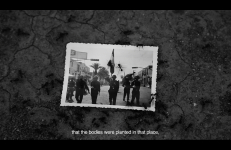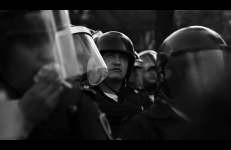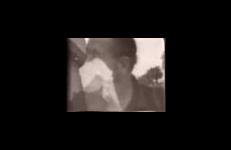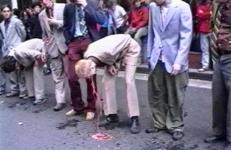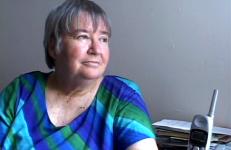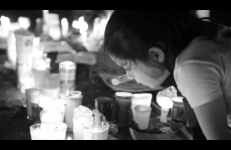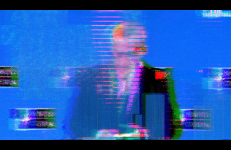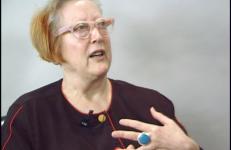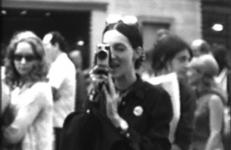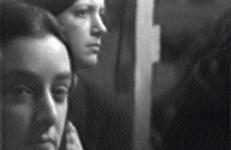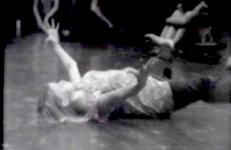While on tour for his new book Exo-Psychology: A Manual on The Use of the Nervous System According to the Instructions of the Manufacturer, Timothy Leary gives a lecture at the University of Illinois Circle Campus (now University of Illinois Chicago). At the start, Leary draws parallels from various cultures from human history and asserts that those who migrated and moved beyond their known environments, the restless and the visionaries, are the ones who advanced human civilization.
Activism
The planting of the "cempasuchil" for the celebrations of the "Day of Death" is one of the last jobs that the Ayotzianapa normal students did before they were brutally disappeared, with small Lomokino 35mm cameras, which we had to compose-hit several times since they are manufactured to be disposable, we record the harvest of the season, with the purpose of impregnating in the fragility of the chemical canvas: the earth, no longer that of the common graves but that other earth that gives light to the work of our fellow Normalistas.
Radio reports analyze staged photographs we do not see, showing the victims of a mass murder committed by Mexican soldiers. The politicization of the film accounts for the duality between framing and mis-framing, and also shows the overflowing character of a process of transit.
A brief dialogue between Marianne Renoir and Pierrot and a short description-reading from ‘Pierrot le fou’ about Diego Velázquez – these intersect with a visual moment to constitute the outline of a perception and the occurrence of the idea of ‘el pueblo,’ of a meeting.
This tape was shot in August 1972 by the same crew that had convened for pioneer video collective TVTV’s (Top Value Television) project Four More Years. Videotaped at the 1972 Republican Convention, it begins with the cameraman taping from inside the press area, with protestors from the People’s Band outside at the fence. There is footage of girl- and boyscout groups. A group of protestors are shown calling for non-violent blockades of the delegates' entrance. Tear gas is feared, and there are interviews with tear-gassed people and medics.
On September 22, 2018 artists Ligorano Reese installed a 2500 pound sculpture of the word Truth carved in ice on the National Mall in front of the U.S. Capitol.
This time lapse video is compiled from over 8 hours of footage. The soundtrack includes Donald Trump over the past 2 years on the Russia investigation and obstruction of justice.
Editing: Marshall Reese & Nora Ligorano
Music composition and performance: Leo Wexler-Mann
Audio Mix: Bill Seery
Rotoscope: Shannon Lee
Colorist: Gavin Guerra
Ice: IceLab, Baltimore MD
Turn It On, Tune It In, Take It Over! is a portrait of freedom of expression at the dawn of the Electronic Age. The video was distilled from hundreds of hours of footage shot mostly in the early 1970s, using the first portable video format—the 1/2" open-reel, black-and-white, battery-operated, video Portapak. The piece recovers an almost lost and forgotten era of television history, when participation set out to conquer passivity, and when process was more important than product.
In Two-Spirits Speak Out, Brenda and Glennda interview members of We'Wah and Bar-Chee-Ampe, one of the first Two-Spirit Native American organizations in New York. This episode addresses gender identity among Two-Spirit people, and discusses their involvement and experiences within the queer community in New York City.
A provocative half-hour of guerrilla artists caught in the act on videotape, Undeniable Evidence is a public art extravaganza assembled by Igor Vamos and anonymous culture jammers.
Ephemeral pieces documented include Grupo Baja Mar/The Low Tide Group. An artists' group uses the unique geologic and architectural features of Spain's San Sebastian's beaches to create a giant public billboard that wipes itself clean each day with the incoming tide. In English and Spanish.
On February 10th, 2005, Lynne Stewart was convicted of providing material support for a terrorist conspiracy. She is the first lawyer to be convicted of aiding terrorism in the United States. Stewart was convicted on charges of conspiracy and providing material support to terrorists in 2005, and sentenced to 28 months in prison. Her felony conviction led to her being automatically disbarred. She was re-sentenced on July 15th, 2010, to ten years in prison in light of her perjury at trial.
An elegy to the popular demands against ominous social and political events in the recent Mexico.
An overview of the Video in the Villages Project, this documentary shows how four different Amazonian native groups (Nambiquara, Gavião, Tikina, and Kaiapó) have embraced video and incorporated it in the service of their projects for political and ethnic affirmation.
Directed and photographed by Vincent Carelli.
An overview of the Video in the Villages Project, this documentary shows how four different Amazonian native groups (Nambiquara, Gavião, Tikina, and Kaiapó) have embraced video and incorporated it in the service of their projects for political and ethnic affirmation.
Directed and photographed by Vincent Carelli.
The story of the anti-Vietnam War movement from the perspective of James R. Roebuck, the first African American president of University of Virginia’s Student Council. Over a ten-day period of unprecedented student upheaval in 1970, Roebuck confronted a series of political challenges and existential dilemmas. This budding activist and future U.S. representative was the quintessential militant insider whose cool temperament and ideological flexibility proved quite useful as UVA appeared on the verge of imploding from within.
The story of the anti-Vietnam War movement from the perspective of James R. Roebuck, the first African American president of University of Virginia’s Student Council. Over a ten-day period of unprecedented student upheaval in 1970, Roebuck confronted a series of political challenges and existential dilemmas. This budding activist and future U.S. representative was the quintessential militant insider whose cool temperament and ideological flexibility proved quite useful as UVA appeared on the verge of imploding from within.
What Could Go Wrong depicts fire trucks, ambulances, fire alarms with sonic distress that document every current disaster….floods, fires, war, food scarcity and police torture are accompanied by Linda Mary Montano singing 7 ballads. The sappy positivity of the songs and the Vision of Mary bring a suggestion that hope is possible. This video is a study in contrasts and when the audience is invited to auditorially interact with it, the message is "action breeds healing" and if so "what could go right."
In Wigstock ’94, Glennda and her friend Bobra attend Lady Bunny’s Wigstock festival. Following the event’s move from the East to the West Village, they explore the changing dynamics and configurations of queer culture in New York. The pair interview other drag queens, members of the local community, and passersby to get a sense of how an event like Wigstock is received by the city.
An episode of Glennda and Friends, hosted by Glennda Orgasm and Bobra. Featuring Jackie Beat, Joan Crawford, Jackie O., Sherry Vine, Nona Vulva, Wendy Wild, and Yumi.
Feminist performance artist, Martha Wilson (b.1947), is director and founder of the alternative New York art space, Franklin Furnace Gallery, in operation since 1976. In this interview, Wilson discusses her Quaker upbringing, the impetus for her move from Nova Scotia to New York, and the founding of Franklin Furnace, as well as her involvement in the feminist punk band collective Disband.
An experimental documentary video project about individuals who have been transformed from so called “ordinary” citizens into activists, Witness To The Future seeks connections that unite people of all cultures, communities, races, and economic classes as they struggle for environmental and social change.
Ten thousand women marched down New York's Fifth Avenue on August 26th, 1970, to mark the fiftieth anniversary of the passage of the 19th amendment, which granted women the right to vote. The march was part of a "Women's Strike for Equality" organized by veteran feminist leader Betty Friedan.
This video, shot in March 1970, contains raw footage from a Women’s Liberation event and discussion that took place in an art space. The tape begins with shots of the crowd mingling while music and speeches are heard in the background. Speakers address the audience, and the tape continues to record the discussion that follows. The main topics are abortion and contraception, and how they relate to power dynamics and the struggle for Women’s Liberation in general.
This video consists of raw footage from a Women’s Liberation Rally in New York City, shot on March 7th 1970, in celebration of International Women's Day. The first two thirds of the piece consist of footage of the crowd and speakers. Many issues are discussed including medical care, childcare, racial solidarity, Puerto Rican liberation, and imperialism. The final third of the tape includes interviews with male and female attendees of the rally.
This tape, shot at the YMCA in Rochester, New York on July 18th, 1971, preserves the informal and communal atmosphere of an event known as the Women’s Conference. The participants, predominantly young white women, appearing to be in their early twenties, spent several hours together gleefully singing, acting, and dancing as an expression of their dedication to women’s civil rights. In various theatrical performances, the participants touch upon subjects such as police violence, racism, freedom, and women’s rights.
Workers Leaving the Factory — such was the title of the first cinema film ever shown in public. For 45 seconds, this still-existent sequence depicts workers at the photographic products factory in Lyon, owned by the brothers Louis and Auguste Lumière, hurrying, closely packed, out of the shadows of the factory gates and into the afternoon sun. Only here, in departing, are the workers visible as a social group. But where are they going? To a meeting? To the barricades? Or simply home?






